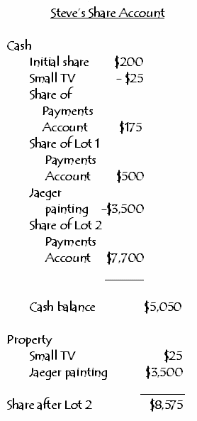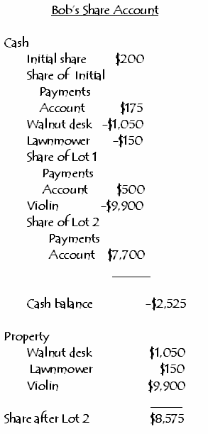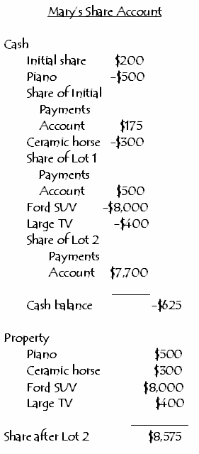|
Example 1: Let's look again at the share accounts for the Snider auction:
Advanced Method
Step 15: When all of the bidding is done, distribute the money and property.
Collect money from any outsiders who successfully bid on items and from anyone with a negative cash balance. Add these amounts to the pool of money and distribute it along with the property as the share accounts direct.
Example 1: Let's look again at the share accounts for the Snider auction:

|

|
 |
After all of the lots are auctioned, the record-keeper should make a "cash account" that includes all of the cash receipts and payments. In the Snider family example, we started with $600 in cash. To that we add the $1,300 that the estate liquidator paid for the green sofa, Bob's payment of $2,525, and Mary's payment of $625. The total amount of cash receipts, then, is $5,050. That amount should equal the amount that needs to be paid to recipients with positive cash balances. In this case, Steve will receive the entire $5,050.
Steve ends up with $5,050, a small TV worth $25, and a painting worth $3,500 for a total share of $8,575. Bob pays $2,525 of his own money, but ends up with a $1,050 walnut desk, a $150 lawnmower, and a $9,900 violin. His total share is also $8,575. Mary pays $625 into the pool of cash, and gets a $500 piano, a $300 ceramic figurine, a Ford SUV worth $8,000, and a large TV worth $400. Her total share is also worth $8,575.
The total value of the property given to Steve, Bob, and Mary is $8,575 X 3 = $25,725.
Hints:
If a recipient with a negative cash balance can't or won't compensate the other recipients, then award some of his or her items to the other bidders. Here's how to do this: Make a list of all the items that were won by the defaulting recipient, and rank them according to the amount of the margin between the winning bid and the second highest bid (or reserve price, whichever is higher), so that items that were won by the smallest margin are at the top. Offer the first item on this list to the second highest bidder (either a recipient or an outsider) for the second highest bid or reserve price, whichever is higher. If the second highest bidder accepts, then rework the accounts and see if the defaulting recipient still has a negative cash balance. If the second highest bidder rejects the offer or if the defaulting recipient still has a negative cash balance, go to the next item on the list and again offer that to the second highest bidder. Keep going down the list until the defaulting recipient no longer has a negative cash balance.
In Step 8, you may have decided to wait until after the auction to sell unwanted items for cash. If so, balance the accounts after these items have been sold. That way, recipients who owe money won't have to dip as much into their own savings to compensate others.
If it's expensive to transfer the title of something (e.g., a house or a car), and the recipient intends to sell it right away, then it might be best to keep the title in the donor's name and allow the recipient to sell the item and pocket the net proceeds.
Step 1 · 2 · 3 · 4 · 5 · 6 · 7 · 8 · 9 · 10 · 11 · 12 · 13 · 14 · 15 · 16
Copyright © 2004 Lori Alden. All rights reserved.